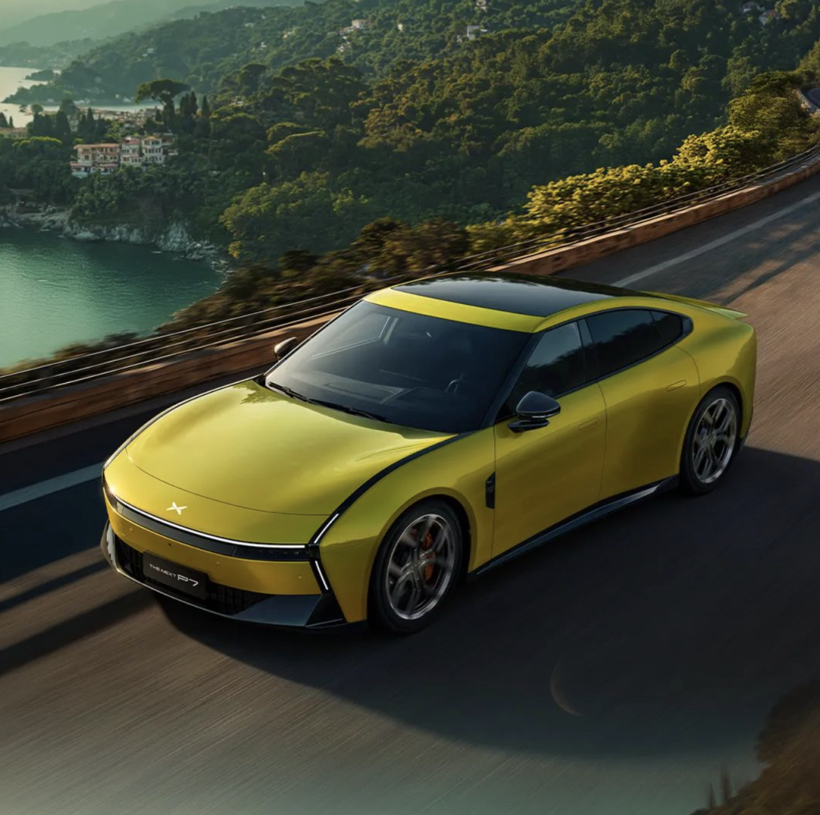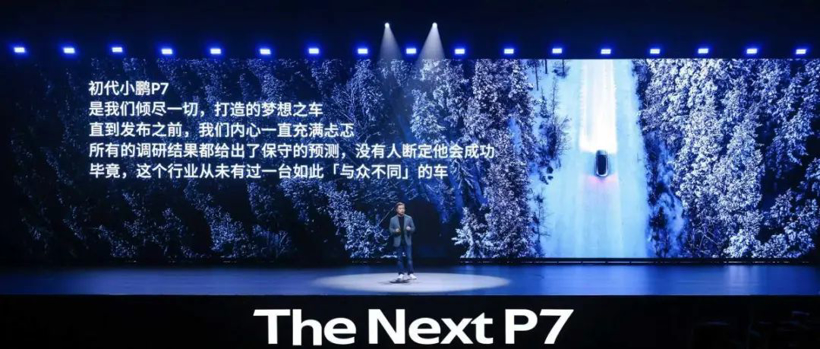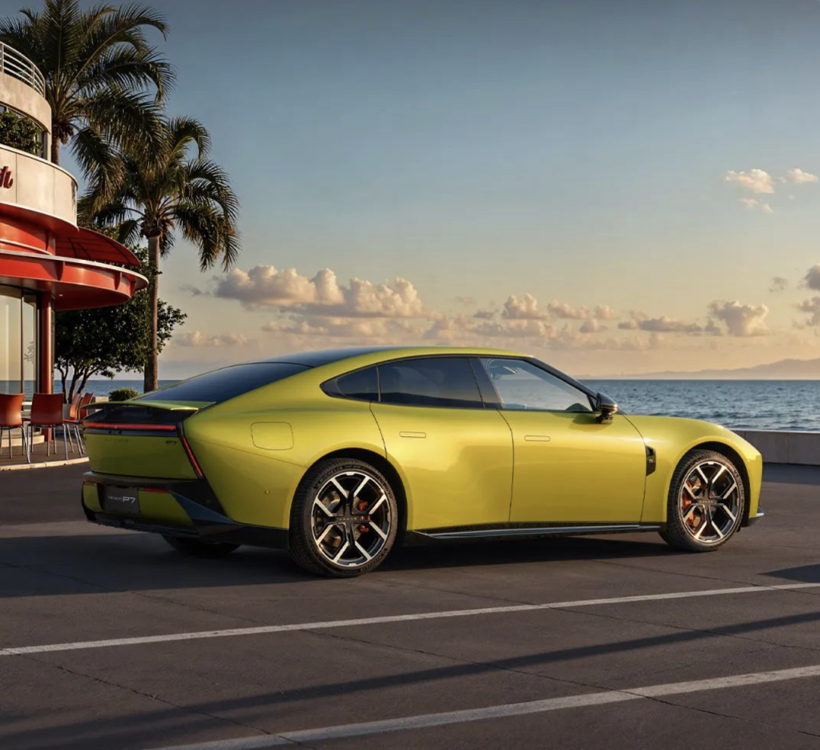Xpeng p7 reborn but not a mass-market car
In the past July, XPeng Motors set a new monthly delivery record, delivering 36,717 smart electric vehicles, a year-on-year increase of 229%. This marks the ninth consecutive month that the company's deliveries have exceeded 30,000 vehicles.
As of July 2025, the company's total cumulative deliveries exceeded 800,000 units. In the first seven months of 2025, XPeng Motors delivered 233,906 smart electric vehicles, a 270% increase compared to the same period last year. With an annual target completion rate of 66.8%, it leads the new forces.
Over the past year, several new models launched by XPeng, including the G7, the MONA series, and the P7+, have become hits in various market segments due to their high cost-performance ratio, collectively propelling XPeng onto the fast track of accelerated growth.
Last night, the all-new XPeng P7 was officially unveiled and opened for pre-orders. Within 6 minutes of the pre-sale launch, pre-orders exceeded 10,000 units. As a significant new release that XPeng holds high expectations for, the new car is set to become another growth highlight for XPeng in the second half of the year.
The new XPeng P7 has been launched in three versions: the 702km long-range version, the 820km ultra-long-range version, and the 750km high-performance version. In this pre-sale, XPeng has not announced the price of the new car. Speculations about the price are generally aimed at competing with the Xiaomi SU7, with the goal of capturing market share in SU7's territory.
The day before the press conference, He Xiaopeng shared some views on the P7. Regarding whether the new P7 is aimed at achieving high sales volume or establishing brand image, He Xiaopeng said that he had not considered the issue from this perspective before.
"Every car has its own mission. The all-new P7 represents our reflection, exploration, and practice of future technology, integrating globally leading technologies. Objectively speaking, I certainly hope it becomes a high-volume popular product, but it is certainly not going to be the kind of affordable car that some Pengyou expect. At this level of configuration, it is indeed unlikely to be a car designed for everyone. It should be the Dream Car for extreme tech idealists, a highly acclaimed ultimate fashion classic trendsetter."
In addition, this new car, within XPeng's overall product lineup, resembles a model in the segment above 200,000 yuan, once again showcasing XPeng's mastery in product definition and authority.
01
A smart sports car driving back to the real world from the future.
At the beginning of the press conference, Xpeng spent quite a long time introducing the design of the new car. Xpeng stated that the underlying logic of car design over the past 20 years has become homogenized. The goal for the new Xpeng P7 from the outset was very clear: to design a product that will be remembered by this era—"a smart sports car that drives back to the real world from the future." The core is to "break free from the shackles of homogenization, adhere to original design, and create a fashion-forward luxury coupe that defies imagination."
In terms of exterior details, the new XPeng P7 adopts the new XMART FACE family design language on the front, featuring the industry's first flush seamless logo, a floating license plate bracket, hidden millimeter-wave radar, and matrix LED headlights, creating a highly futuristic visual symbol.
The aspect ratio of 1.40, the length-to-height ratio of 3.57, and the wheel-to-height ratio of 0.52 create a wider, lower, and more elongated body proportion. Combined with a mid-mounted electric drive layout consistent with supercars, it constructs a coupe-like stance that embodies both a sense of speed and stability.

In addition to its extremely low and sleek coupe stance, its sporty genes and the 885 electric power system are also highlights of the new car. The entire vehicle adopts a mid-mounted electric drive layout architecture similar to that of a supercar, with the axle mass accounting for 81% of the total vehicle mass and a center of gravity height of 440mm, providing handling stability akin to flying close to the ground.
The new car achieves 0-100 km/h acceleration in 3.7 seconds, with a top speed of 230 km/h, comparable to million-level luxury sports coupes. The chassis features a class-leading all-aluminum front double wishbone and rear five-link suspension, combined with lightweight forged wheel design and optimized unsprung mass, resulting in more agile steering and a more responsive body. Additionally, it is equipped with dual-chamber air suspension and intelligent variable damping shock absorbers, allowing for seamless switching between daily comfort and sporty handling.
The new car is built on a full-domain 800V high-voltage SiC platform and is equipped with a 5C ultra-fast charging AI battery, significantly enhancing energy replenishment efficiency—providing 525 km of range in just 10 minutes of charging. Charging from 10% to 80% takes only 11.3 minutes, truly achieving "charging like refueling."
Certainly, as a benchmark for intelligent coupe performance, one of the highlights of the all-new XPeng P7 lies in its fully-powered AI capabilities.
The entire lineup of new cars is equipped with three Turing AI chips, along with the Qualcomm 8295P, forming a "super AI hub." With an effective computing power of 2250 TOPS, it ranks first globally and is equipped with VLA+VLM dual large models, enabling the car to think and evolve, providing a more powerful intelligent driving assistance and smart cabin experience.
AR-HUD and AI intelligent chassis, along with pioneering technological configurations, enable AI to deeply participate in road prediction and proactively respond, offering a futuristic travel experience of "human-machine integration."
The front row of the new car offers integrated mobile seats, and the driver's seat also supports an active side bolster function, providing additional support and wrapping when the vehicle enters a corner at high speed. Both the driver and passenger seats support ventilation and heating.
Additionally, the new car features minimalist frameless rearview mirrors and an electric lift spoiler; a triple silver-plated canopy and four-door silent electric suction doors; a 56-liter front trunk and a 575-liter super large capacity rear trunk; 23 custom HiFi-grade speakers supporting 7.1.4 channel AI surround sound...
Overall, the all-new XPeng P7 excels in design, power, space, and intelligence, with almost fully loaded software and hardware configurations, showcasing considerable competitiveness in terms of product strength.
02
From the first generation P7 to the all-new P7, the market environment has changed significantly.
In the domestic pure electric coupe market, if one is to find a representative product, the first-generation XPeng P7 is certainly an unavoidable presence.
Five years ago, when the first-generation P7 model was unveiled, it introduced several industry firsts: the world's first mass-produced high-speed intelligent assisted driving system, the first fully voice-operated in-car system to be innovated and mass-produced, the world's first pure electric vehicle with a range exceeding 700KM, and completely personalized and technologically advanced continuous taillights. These innovations essentially laid the foundation for the future of Chinese electric vehicles.
At that time, the Chinese car market saw the Tesla Model 3 as almost synonymous with electric sedans, and China's new energy vehicle industry was just beginning. He Xiaopeng said that the first generation P7 was a dream car that Xiaopeng poured everything into building, and it was a unique new car in the industry, with no one able to predict its success.

The arrival of the first-generation P7 undoubtedly marked the beginning of a new era for Chinese electric sedans. As the first Chinese new energy vehicle model to reach 100,000 units sold, it helped XPeng Motors establish a firm foothold in the Chinese automotive market. Alongside NIO and Li Auto, collectively known as "Wei Xiaoli," it represents China's new powerhouses, altering the situation where Tesla was the sole dominant player.
Afterwards, XPeng experienced a roller-coaster-like few years. Following the P7, XPeng fell into a slump due to the chaotic configuration strategy of the G9 and the impact of external competitors, with sales dropping to an average of less than 10,000 units per month. In 2023, XPeng's annual sales were overtaken by Leapmotor. Additionally, during this period, XPeng faced the dual impact of price cuts in the pure electric track and Huawei's intelligent technology, leading to a noticeable lag in sales growth.
In 2024, XPeng embarked on bold reforms, making adjustments to organizational structure, product strategy, technology cost reduction, supply chain, and more, and quickly launched several popular models. With MONA, which "first brought advanced intelligent assisted driving to the $20,000 level," and the P7+ equipped with a new generation AI Eagle Eye vision system, XPeng swiftly achieved a breakthrough that year.
In the fourth quarter of 2024, it achieved a then-record high of 91,507 deliveries in a single quarter, with annual revenue growth of 33.2%, a gross margin increase to 14.3%, and a net loss reduction of 44%.
In 2025, XPeng experienced a full-scale breakout in various market segments. With several best-selling models, including MONA, P7+, X9, the 2025 versions of G6/G9, and the all-new G7, the company achieved an average monthly sales volume of over 30,000 units for eight consecutive months, setting a new historical record. The sales volume for the first half of the year already surpassed the total for the entire year of 2024.
Since its launch, the XPeng MONA has delivered over 10,000 units for 11 consecutive months, with cumulative deliveries exceeding 150,000 units as of July, continuously setting records in the A-class pure electric sedan market. The XPeng P7+ has cumulatively delivered over 67,000 units, retaining the top-selling position in the 150,000-200,000 RMB mid-to-large pure electric sedan category for 8 consecutive months.
The 2025 XPeng X9 has consecutively held the title of best-selling all-electric MPV for several months. The XPeng G7, the world's first AI car with L3-level computing power, which was just launched in July, received over 10,000 orders within 9 minutes of its release.
Five years after the launch of the first-generation P7, the Chinese automotive market has undergone tremendous changes. The environment faced by the newly launched P7 is now entirely different. Among the dazzling array of homogenized competitors, how the new P7 finds its differentiation will be a significant challenge for XPeng moving forward.

03
How to achieve overall profitability in the fourth quarter
In recent years, XPeng has built a full-stack self-research system and leading advantage centered on AI. This includes the AI Eagle Eye Vision Intelligent Driving Solution, Turing AI chips, a cloud-based large-scale foundational model, a fully locally deployed VLA model, as well as a new generation of EEA architecture for the whole vehicle, a physical simulation system, intelligent cockpits, embodied intelligent robots, flying cars, and more. "Some key AI capabilities will achieve a generational lead in the industry by 2026."
He Xiaopeng hopes to develop XPeng Motors into an "AI technology company" and also aims for it to grow into a "global enterprise." In the first quarter of this year, XPeng Motors announced three growth trajectories, one of which is expanding from the Chinese to the global market. It is expected that the overseas business will expand rapidly in the next three years, becoming an important driver of sales and profit growth.
In the first half of this year, XPeng's overseas deliveries reached 18,701 units, representing a 217% increase compared to the same period in 2024. It achieved the top sales position among Chinese emerging brands in 10 overseas countries, including Denmark, Norway, Finland, Ireland, the Netherlands, and Portugal.
In mid-July, XPeng Motors launched the 2025 models of XPeng G6 and G9 in the European market, and announced the upcoming launch of the XPeng P7+ in Europe. Currently, XPeng has entered 46 countries and regions worldwide, with a charging network covering 2.07 million charging piles in 31 countries. It has established partnerships with international companies such as Volkswagen and bp pulse, gaining a certain level of recognition in the European high-end pure electric market.
Previously, the XPeng G6 had become the best-selling Chinese model in the European mid-to-high-end pure electric mid-size SUV market, while the XPeng G9 was the best-selling Chinese model in the European mid-to-high-end pure electric mid-large-size SUV market.
In addition, XPeng has planned two other growth trajectories: the integration of AI and automobiles, and the deeper integration of embodied humanoid robots with the automotive industry.
On July 15th, XPeng AeroHT announced the completion of a $250 million Series B funding round. This funding will be used to ensure the smooth advancement of the development, mass production, and commercialization of XPeng AeroHT's flying cars. The mass production process of the "land aircraft carrier" is accelerating comprehensively. XPeng AeroHT's world's first flying car mass production factory has been topped out and is currently undergoing equipment debugging. It is planned to be completed in the fourth quarter of this year, and the "land aircraft carrier" will be mass-produced and delivered in 2026.
However, these two curves will be propositions for a longer cycle, especially in terms of R&D and large-scale commercial application implementation. In the short term, XPeng still needs to face the reality of limited investment and commercial returns.
Thanks to effective cost control and economies of scale, XPeng's gross profit has seen significant improvement and enhancement over the past year, and He Xiaopeng has set the target for overall profitability in the fourth quarter of this year. This also means that each quarter of this year needs to serve as a stable point for boosting revenue, reducing losses, and enhancing efficiency conversion.
However, relying solely on low-priced popular products to capture the market is definitely unsustainable. If the product structure cannot develop systemic capabilities, profitability will only be a temporary figure.
The launch of the more expensive new P7, if it performs better in sales, will significantly help boost XPeng's overall gross profit and, to a large extent, propel XPeng Motors onto a path of steady growth.
【Copyright and Disclaimer】The above information is collected and organized by PlastMatch. The copyright belongs to the original author. This article is reprinted for the purpose of providing more information, and it does not imply that PlastMatch endorses the views expressed in the article or guarantees its accuracy. If there are any errors in the source attribution or if your legitimate rights have been infringed, please contact us, and we will promptly correct or remove the content. If other media, websites, or individuals use the aforementioned content, they must clearly indicate the original source and origin of the work and assume legal responsibility on their own.
Most Popular
-

List Released! Mexico Announces 50% Tariff On 1,371 China Product Categories
-

EU Changes ELV Regulation Again: Recycled Plastic Content Dispute and Exclusion of Bio-Based Plastics
-

Mexico officially imposes tariffs on 1,400 chinese products, with rates up to 50%
-

Clariant Unveils Cost-Cutting Plan Details, Plans to Shut Down Multiple Plants
-

Nissan Cuts Production of New Leaf EV in Half Due to Battery Shortage






